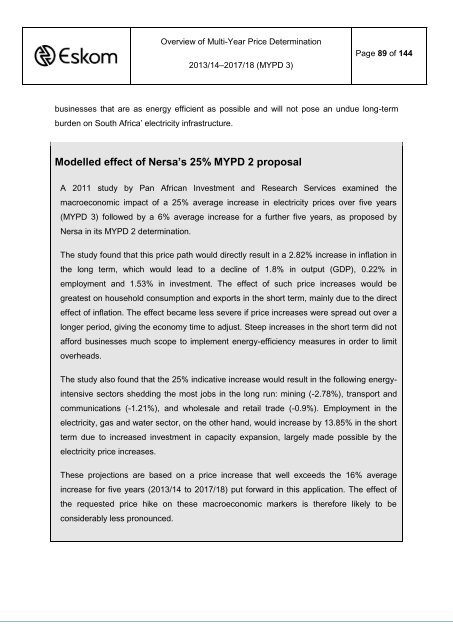Part 1 Revenue Application: Multi-Year Price Determination ... - Eskom
Part 1 Revenue Application: Multi-Year Price Determination ... - Eskom
Part 1 Revenue Application: Multi-Year Price Determination ... - Eskom
You also want an ePaper? Increase the reach of your titles
YUMPU automatically turns print PDFs into web optimized ePapers that Google loves.
Overview of <strong>Multi</strong>-<strong>Year</strong> <strong>Price</strong> <strong>Determination</strong><br />
2013/14–2017/18 (MYPD 3)<br />
Page 89 of 144<br />
businesses that are as energy efficient as possible and will not pose an undue long-term<br />
burden on South Africa‟ electricity infrastructure.<br />
Modelled effect of Nersa’s 25% MYPD 2 proposal<br />
A 2011 study by Pan African Investment and Research Services examined the<br />
macroeconomic impact of a 25% average increase in electricity prices over five years<br />
(MYPD 3) followed by a 6% average increase for a further five years, as proposed by<br />
Nersa in its MYPD 2 determination.<br />
The study found that this price path would directly result in a 2.82% increase in inflation in<br />
the long term, which would lead to a decline of 1.8% in output (GDP), 0.22% in<br />
employment and 1.53% in investment. The effect of such price increases would be<br />
greatest on household consumption and exports in the short term, mainly due to the direct<br />
effect of inflation. The effect became less severe if price increases were spread out over a<br />
longer period, giving the economy time to adjust. Steep increases in the short term did not<br />
afford businesses much scope to implement energy-efficiency measures in order to limit<br />
overheads.<br />
The study also found that the 25% indicative increase would result in the following energy-<br />
intensive sectors shedding the most jobs in the long run: mining (-2.78%), transport and<br />
communications (-1.21%), and wholesale and retail trade (-0.9%). Employment in the<br />
electricity, gas and water sector, on the other hand, would increase by 13.85% in the short<br />
term due to increased investment in capacity expansion, largely made possible by the<br />
electricity price increases.<br />
These projections are based on a price increase that well exceeds the 16% average<br />
increase for five years (2013/14 to 2017/18) put forward in this application. The effect of<br />
the requested price hike on these macroeconomic markers is therefore likely to be<br />
considerably less pronounced.

















